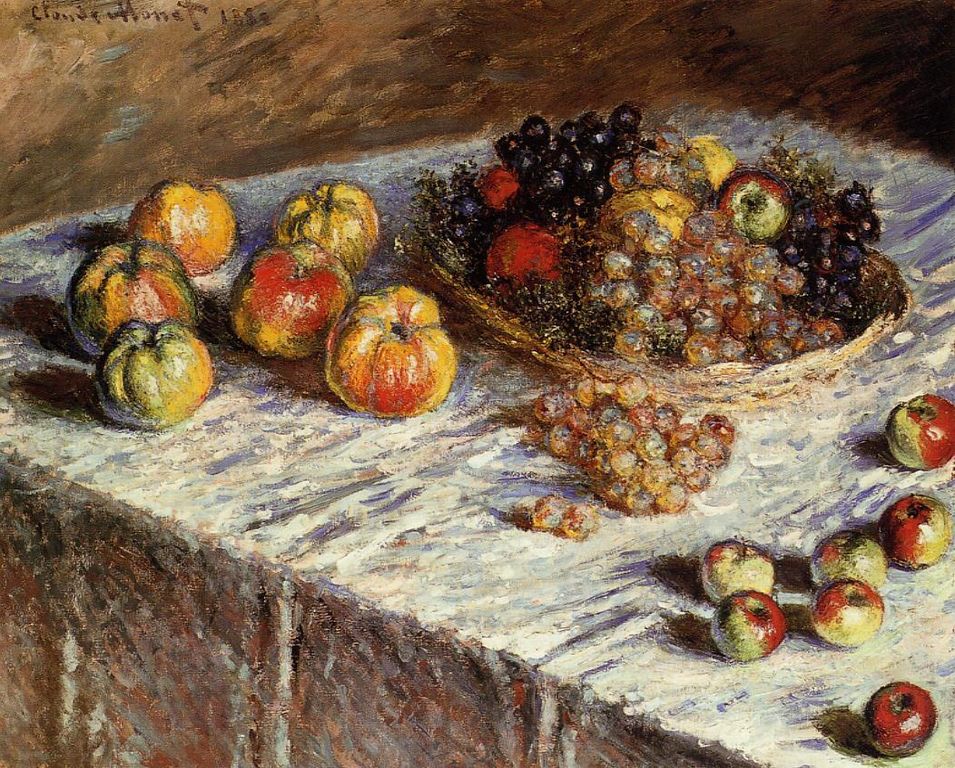This legendary French pastry apple is not really for eating out of hand. But eat we must.

|
Calville is a large medium (or small large) apple with pronounced, even exaggerated, ribbing. It is yellow tinged with green and there is a partial blush over perhaps a quarter of the peel.
Large green lenticels are prominent though not in the blush. In hand the
unbroken fruit feels firm and solid and smells of pear and bananas.
Inside Calville Blanc is a light yellow with a tender crunch, fine-grained and dense. Its flavor balance tilts slightly to the tart but there is sweetness too, to frame pear flavors with a hint of banana in the finish. There are also some unusual salty, mineral notes.
For a cooking apple this is not bad, but Calville does not shine for eating, though he rewards the attentive taster with some unusual flavors. It may take an oven to unlock these tastes fully.
If it's wasteful to eat rather than cook one of these, I have erred twice, for I had another sample and ate it too. Since No. 2 was from a different orchard in a different state I thought it would give me especially good "coverage" to taste both.

|
Just doing my job. But next year if I'm fortunate enough to get a few of these perhaps I will assay a tarte aux pommes.
The second sample was crisper and generally better textured. I could imagine it surviving the oven quite well.
It was also more tart, astringent, and acid, its flavors more tightly wound. The banana was a little more prominent and there was a faint hint of lemon chiffon.
As you can see Calville No. 2 had the extreme lobed ribbing that this variety sometimes exhibits. It comes from a very-minimal-spray orchard and has many of the usual blemishes--a right gnarly specimen all around, beautiful in its way.
Claude Monet liked the look of these too. Here they are in his Still Life
with Apples and Grapes.

|
| Public-domain image courtesy of Wikimedia Commons |
Callville Blanc d'Hiver originated in the early 16th century, some say in Normandy. By the time Monet executed his still life the apple had certainly spread to every corner of France. Today it remains the correct apple for the traditional tart.
So is there a white Calville of summer? Yes, as it turns out, and a rouge d'hiver too.

Yes, not only a Calville Blanc d'Été, but a Calville Malingre for all you malingerers! Thanks for the link, it was great to read about all the Calvilles d'Saisons.
ReplyDeleteI have just purchased two Calville Blanc d'Hiver for my small orchard. Can you please tell me how long it will take before the tree will bear fruit. The tree I am buying (bareroot) is three years old. Thank you so much. Was just in Monet's house this past October. His small apple cordons were fruiting.
ReplyDeleteAlas, my expertise (if that is what it is) is limited to eating apples, not growing them. (A tough job, but someone, you know, must do it.) Sorry!
DeleteYou might try your state's agricultural extension service or equivalent program for advice.
Anon, it largely depends on the root stock. Calville is slow to bear in general, so on standard rootstock it could take seven years or more. On fully dwarfing rootstock it could start bearing within two or three seasons. Bareroot that is three year's old may be trickier to transplant (due to loss of root system), but if successfully planted, the tree should reach first fruiting sooner.
ReplyDeleteWhat John said. (And thank you, Mr. H., for helping out!)
DeleteJohn, thanks. My two Calville Blanc d'Hiver are on semi dwarfing stock and both trees arrived with six clusters of flowers each. Even though the tree have rooted (the systems were huge) I have removed every cluster for this year. It looks good for at least one apple per tree next year to at least eat! thanks
ReplyDeleteThanks again to John Henderson, and thanks to Anonymous for checking back in. May your apples never grow mealy!
DeleteYes, overall to rootstock. I have grafted these on 10 different rootstock and looking forward to the differences. Skipley Farm, custom trees
ReplyDeleteSquirrels adore these apples and will eat them green before they even ripen. They will completely strip the tree if you do not control them. Delicious apple, I love it fresh
ReplyDeleteThe Calville Blanc d’Hiver is *the* historic apple used for tarte tatin. It has replaced my favorite Northern Spy for apple pies, as it can be sliced relatively thin yet holds shape and structure after cooking. Its flavors are fully at their best after cooking: deep tangy sweetness, a lovely, full-bodied apple flavor with a banana finish. I use less sugar when I make a pie with them because the sweetness of this variety after cooking allows it, and I use minimal spices (only a slight dash of cinnamon) because the flavor of these apples is so beautiful. I do also enjoy these as an eating apple. They store well for a lengthy time period and sliced with a dollop of peanut butter they’re the perfect snack: crispy, juicy, crunchy, tart. All in all, a lovely apple. Gotta hand it to the French!
ReplyDeleteThere seems to be two theories about apples for cakes and pie: structure versus a kind of mush, both delicious but different. See Calville for the former, Bramley for the latter.
DeleteFor a tarte I think there is no question that mush would be a disaster.
I'm not much of a baker, but did enjoy making a "tarte Tintin." (With Calville, bien sûr!)